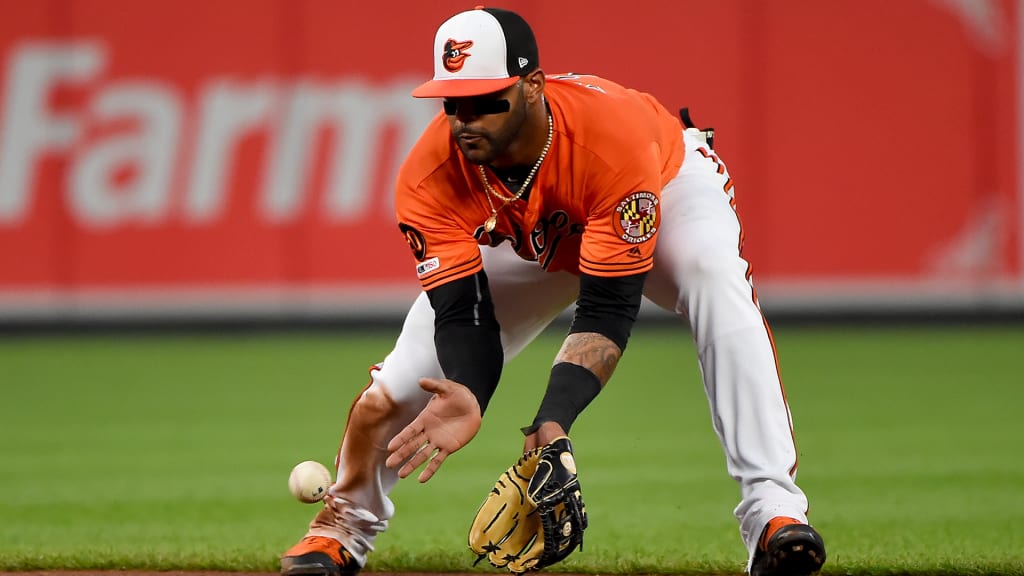
BALTIMORE -- Earlier this spring, innocently but honestly, Jonathan Villar admitted he’d prefer to play shortstop. A shortstop by trade but comfortable on both sides of the bag, Villar had no idea how much being the Orioles' everyday second baseman would still provide him the chance.
“We shift so much that, I’m playing short [a lot],” Villar said.
Not just a lot. More than almost any other second baseman in baseball.
That’s partially because with the Orioles easing Rule 5 Draft shortstop Richie Martin into everyday action, Villar has started at short 14 times, most recently Friday night against the Angels. But it’s also because playing in this Orioles infield means shifting a lot, more so than ever in franchise history.
Coming off a season when they ranked as one of the Majors' poorest defensive teams by a variety of metrics, the Orioles’ new regime sought to make defense a priority for their young group from Day 1. The change in philosophy makes sense, given the data-driven approach of the club’s new brain trust.
General manager and executive vice president Mike Elias and assistant general manager Sig Mejdal were key members of front offices in Houston that popularized infield overshifting earlier this decade. Manager Brandon Hyde came from the Cubs, who famously shuffle their star players all around the diamond in search of flexibility. Infield instructor and third base coach Jose David Flores was hired from the Phillies, who increased their rate of infield shifting dramatically in his lone season on their big league staff.
Let's breakdown what they've combined to bring to Baltimore, what it's looked like and how it's worked so far.
How much are they shifting?
Simply put, basically every other hitter. Entering Friday, the Orioles placed three fielders on one side of second base 648 times in 1,447 opportunities, the most among all MLB teams. That translated to 44.8 percent of the time, second only to the Astros, who’ve led this category every year since Statcast began tracking such data in 2016.
Baltimore isn’t exactly new to the shift game, having ranked among the top 10 clubs in overall shift rate every season since 2016. It placed seventh in 2018.
But the Orioles have taken it to a new level this season, their shift percentage jumping 22 percent early on. That’s the biggest gain of any team in the Majors, and makes them something of new poster boys for a continuing league-wide trend. A full quarter (24.8 percent) of Major League at-bats have been taken against a shift this season, up from 17.4 percent in 2018 and by far the most on record.
When are they shifting?
Here is when Villar comes in, and where things get really interesting. Traditional shifting against left-handed hitters is skyrocketing everywhere, the league rate at 41 percent compared to 30 percent last season. The Orioles are a big reason why. They’re shifting against lefties 67 percent of the time, again behind only Houston but 20 percent more than the next closest club, the Twins. That’s a 33.5 percent increase from last season, tops in the Majors.
But Villar must move left so often because the Orioles are shifting so much more against right-handed hitters, who are no longer spared from facing three-man infield walls. Baltimore is shifting 32 percent of the time vs. righties this season, and 18 percent more than in 2018. Both rank second in the Majors, behind only Minnesota.
“We shift pretty heavily, and I think we’ve done a really good job. We’re in the right spot a lot. Our guys have bought in,” Hyde said. “It’s a little bit of a combination: guys we have on the mound, combined with how we’re going to pitch, to the hitter’s strengths and weakness, spray chart data, to things that we believe in.”
Is it working?
Yes and no. The results are mixed, though they only tell part of the story.
Baltimore has converted 31.5 percent of its grounders to the left side into outs, per Statcast, which ranks ninth in the Majors. That’s good. But their 69 percent conversion rate on grounders to the right side ranks 22nd. That’s below average.
With shifts on, the number against lefties actually decreases to 58 percent. Baltimore has also allowed the highest weighted-on-base average with the shift on against righties. Even including their recent stretch of strong pitching, this is a staff surrendering runs and extra-base hits like no other in the game.
And that’s part of the point of all the shifting, more a cause than an effect. No amount of infielders can do a thing about home runs, which the Orioles are allowing at record rates. Hitters are torching their staff at an average exit velocity of 90.3 mph on balls in play, the highest in the big leagues. It’s that type of hard contact the Orioles must find creative ways to mollify.



